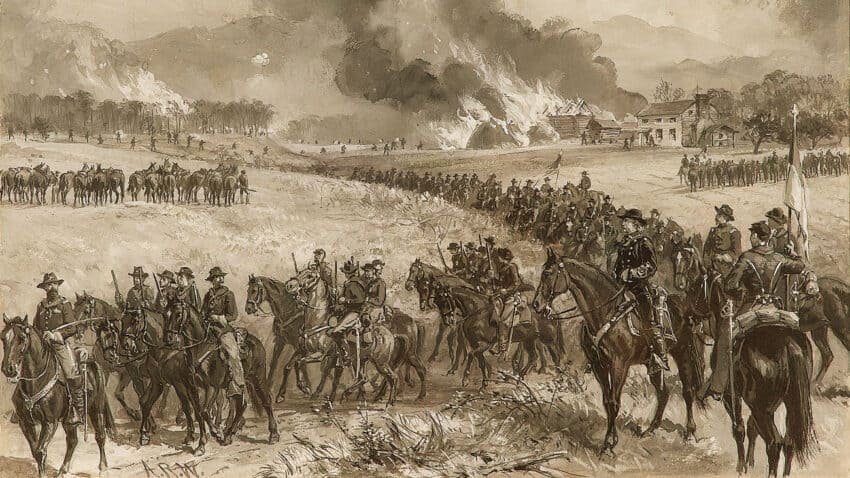
During the burning of the Shenandoah Valley, the U.S. Army (Union Army) destroyed what they could not take: barns, mills, fields of grain, and livestock.
Image courtesy of Library of Congress
June 7, 1863 – June 20, 1863
By Phil Kohn
Phil Kohn can be reached at USCW160@yahoo.com
In an attempt to relieve the pressure on besieged Vicksburg, Mississippi, Confederate Maj. Gen. Richard Taylor’s troops on June 7, 1863, attack Grant’s forces at Milliken’s Bend and Young’s Point, Louisiana. The Southerners push the Federals back but are driven off by Union gunboats. Taylor then moves his operations to the southern part of the state. On the same day, Union soldiers sack and burn Brierfield, Jefferson Davis’s plantation in Mississippi, located about 18 miles southwest of Vicksburg.
At Culpeper, Virginia, on June 8, Confederate Maj. Gen. “Jeb” Stuart stages a second cavalry review, this time attended by Gen. Robert E. Lee and other dignitaries. At Vicksburg, Mississippi, Maj. Gen. Grant’s artillery starts shelling the city, the beginning of what will be 24-hour-a-day bombardment. To avoid the barrage, some citizens take refuge in the many caves found around the city.
On June 9, Union cavalry commanded by Maj. Gen. Alfred Pleasanton attacks Confederate troopers under Maj. Gen. “Jeb” Stuart at Brandy Station, Virginia. The Southern cavalry had been demonstrating and holding reviews between Fredericksburg, Virginia, and the Blue Ridge Mountains to deflect attention from Robert E. Lee moving his main body of forces into the Shenandoah Valley. The 12-hour action at Brandy Station, with approximately 10,000 troopers on a side, is the largest cavalry battle of the war. Although the action ends pretty much in a draw, it marks a turning point, as it is the first time U.S. cavalry is able to hold its own against Southern mounted troops.
As word spreads in communities north of the Potomac River that the Confederate Army is on the move and approaching, and worries mount, President Lincoln once again urges Maj. Gen. Hooker to fight the enemy “when the opportunity offers. If he stays where he is, fret him.” The chartered civilian steamship Maple Leaf is transporting 97 Confederate officers who are prisoners of war from Fort Monroe, in Virginia, to Fort Delaware, on Pea Patch Island, in the Delaware River between Delaware and New Jersey. Learning that they will not be exchanged, as they had thought, the prisoners rise up and overcome the 12 soldiers guarding them and force the vessel to head towards shore near Cape Henry, Virginia. Using Maple Leaf’s small boats, most of the officers make it to shore and split into smaller groups. Maple Leaf makes the four-hour trip back to Fort Monroe to report the escape and cavalry is dispatched to hunt for the escapees, but to no avail. Aided by sympathetic locals, most of the prisoners make it back to Confederate lines.
Ohio Peace Democrats, on June 11, nominate Clement Vallandigham, as their gubernatorial candidate. On the same day, Vallandigham, convicted of treason and banished from the U.S. and sent to the Confederacy in May on the orders of President Lincoln, is deported to Canada as an “enemy alien” by the Confederate government. Darien, Georgia, is raided by the 54th Massachusetts Infantry, led by Col. Robert Shaw.
On June 12, Pennsylvania governor Andrew Curtin, anticipating an invasion and attack by the Confederate Army, calls out the militia to help defend the state, and requests assistance from New York. Moving northward, Gen. Lee’s Confederates clash with Federal troops at Newtown, Cedarville and Middletown, Virginia.
Gen. Lee’s 2nd Corps, led by Lt. Gen. Richard Ewell, moves into the area of Winchester, Virginia, on June 13 where it engages with Federal troops under Maj. Gen. Robert Milroy in the Second Battle of Winchester, fought over the next two days.
Maj. Gen. Nathaniel Banks on June 14 launches 6,000 Union soldiers in an assault on Port Hudson, Louisiana, but is held off by the garrison of 3,750 Confederates. By the end of the month, Banks will have a total of 20,000 troops besieging the fort that guards the Mississippi River above Baton Rouge.
Confederates under Lt. Gen. Richard Ewell, part of Lee’s Army of Northern Virginia, overrun Federal forces at Winchester, Virginia, on June 15, capturing 23 guns, 300 horses and 300 wagons laden with ammunition, food and other supplies. President Lincoln asks the governors of Pennsylvania, Maryland, Ohio and West Virginia to supply 100,000 militia troops to repel the Confederate invasion. Lincoln receives a troubling message from Maj. Gen. Joseph Hooker, commanding the Army of the Potomac, that the Southern invasion “is not in my power to prevent.”
On June 16, Ewell’s Confederates cross the Potomac River at Williamsport, Maryland, and occupy the western portion of the state. Meanwhile, Maj. Gen. Hooker moves and positions his Army of the Potomac at Fairfax Courthouse, Virginia, about 15 miles west of Washington, D.C. Hooker wants to move north of D.C., but Maj. Gen. Halleck, commander-in-chief of the Army, instead wants him to follow Lee’s force.
In Georgia, on June 17, the Confederate ironclad CSS Atlanta is forced to surrender after a clash with the Federal vessels USS Weehawken and USS Nahant at the mouth of the Wilmington River in Wassaw Sound, near Savannah. In Ohio, some 420 Federal troops, including members of the 3rd Ohio Infantry, descend on the town of Napoleon, in Holmes County, to confront 900-1,000 local citizens who oppose the Federal conscription law. Previously, locals had attacked a conscription official and then built a makeshift fort that includes four cannons to oppose further efforts to impose the draft. After a brief action, in which two resisters are wounded, the locals capitulate. In all, 80 men are arrested for their anti-draft activities. Only two stand trial, however, and only one is convicted. He is sentenced to six months of hard labor at the Ohio Penitentiary but is pardoned by President Lincoln before his sentence is completed. Charges against the other 78 men are dropped.
On June 18, Maj. Gen. Ulysses S. Grant relieves Maj. Gen. John McClernand of command of the XIII Corps. McClernand — a “political” general — has a history of insubordination and an unwillingness to cooperate with the rest of the army. However, the straw that breaks the camel’s back is McClernand’s going public with the claim that he is responsible for the success of the Vicksburg campaign. McClernand is replaced by Maj. Gen. Edward O.C. Ord.
West Virginia is officially admitted to the Union as a state on June 20. In Louisiana, Confederates under Maj. Gen. Richard Taylor, moving east from Thibodaux (about 20 miles southwest of New Orleans), clash with Federals at LaFourche Crossing, but make no headway. North and west of Baltimore, Maryland, breastworks are built to defend against possible Confederate raids.







